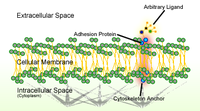
Photo from wikipedia
Three-dimensional (3D) scaffolds with chemical diversity are significant to direct cell adhesion onto targeted surfaces, which provides solutions to further control over cell fates and even tissue formation. However, the… Click to show full abstract
Three-dimensional (3D) scaffolds with chemical diversity are significant to direct cell adhesion onto targeted surfaces, which provides solutions to further control over cell fates and even tissue formation. However, the site-specific modification of specific biomolecules to realize selective cell adhesion has been a challenge with the current methods when building 3D scaffolds. Conventional methods of immersing as-prepared structures in solutions of biomolecules lead to nonselective adsorption; recent printing methods have to address the problem of switching multiple nozzles containing different biomolecules. The recently developed concept of macroscopic supramolecular assembly (MSA) based on the idea of "modular assembly" is promising to fabricate such 3D scaffolds with advantages of flexible design and combination of diverse modules with different surface chemistry. Herein we report an MSA method to fabricate 3D ordered structures with internal chemical diversity for site-selective cell adhesion. The 3D structure is prepared via 3D alignment of polydimethylsiloxane (PDMS) building blocks with magnetic pick-and-place operation and subsequent interfacial bindings between PDMS based on host/guest molecular recognition. The site-specific cell affinity is realized by distributing targeted building blocks that are modified with polylysine molecules of opposite chiralities: PDMS modified with films containing poly-l-lysine (PLL) show higher cell density than those with poly-d-lysine (PDL). This principle of selective cell adhesion directed simply by spatial distribution of chiral molecules has been proven effective for five different cell lines. This facile MSA strategy holds promise to build complex 3D microenvironment with on-demand chemical/biological diversities, which is meaningful to study cell/material interactions and even tissue formation.
Journal Title: ACS applied materials & interfaces
Year Published: 2021
Link to full text (if available)
Share on Social Media: Sign Up to like & get
recommendations!